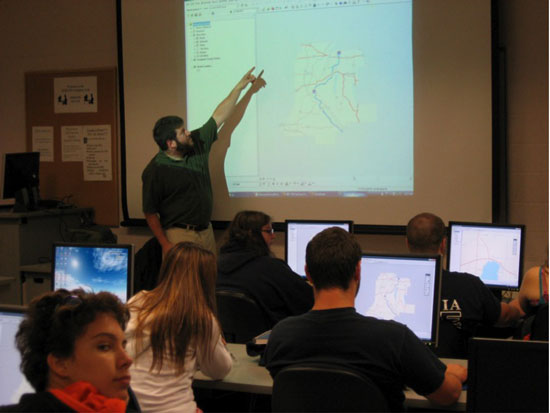Livonia Students Learn to Map Disasters with Geographic and Imaging Systems
Latest disaster management technology featured during daylong program
B. Tomaszewski
Brian Tomaszewski demonstrates geographic information systems to students from Livonia High School who visited RIT recently.
Using a simulated disaster scenario of a chemical accident on a highway near their school, Livonia High School students soon discovered how important geographic information systems and imaging science could be to their town during a disaster.
A group of 20 high school students from Livonia, N.Y., visited Rochester Institute of Technology recently to learn more about the technologies being used to assess risks and manage natural disasters. They were part of a daylong program organized by Brian Tomaszewski, assistant professor, College of Applied Science and Technology, and Brian Sheldon, earth science faculty at Livonia High School. Sheldon brought his Natural Disasters class to RIT to learn about the use of GIS and imaging science in disaster management.
“GIS was cool,” says Dan Knight, a senior. “It was amazing how much information can be placed on a map. I am thinking about GIS as a field to get into.”
Knight and several of his classmates also found the demonstration of the thermal camera of interest. Joe Pow, associate director, Chester F. Carlson Center for Imaging Science, used the camera to show heat maps, or internal images, using several students in the class as models. “Who knew a camera could see such variation? Who knew we had so much variation in our body temperature?” Knight added.
Nathan Green, an RIT graduate student, showed the class how to use GIS to layer, manipulate, and visually represent information about natural and man-made environments. Through hands-on exercises, students were able to see their high school and other geographical information such as roadways, water, railroads, elevation and aerial photographs using an interactive map. Bethany Choate, science outreach specialist, Center for Imaging Science, led students through an overview of the programs offered by the center and the life cycle for image processing.
“Overall, the event was a success for teaching the students about topics which are not part of a standard high school curriculum, and for getting the students interested in pursuing college after high school, hence the visit during the day by the dean of the College of Applied Science and Technology, Fred Walker, a campus tour and visit to the dining hall,” says Tomaszewski. “Bethany’s insights into her own experiences with high school internships at RIT struck a chord with some of the Livonia students.”



